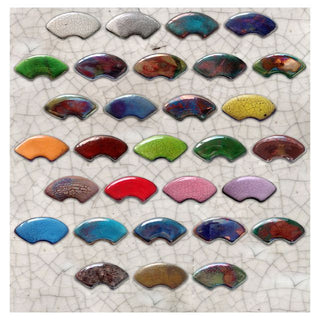850 Series Raku Glazes
Spectrum 850 series Raku Glazes
 Series: 850 to 879 Glaze Type: Low Temperature
Series: 850 to 879 Glaze Type: Low Temperature
Raku glazes are some of the most popular choices due to the beautiful and unique appearance that each piece offers. Spectrum 850 Series Raku Glazes can be applied by brush, poured, or used for dipping. These glazes can be fired up to cone 06.
Due to the many variables involved in Raku firing, particularly during the reduction phase, our chip charts and printed color charts should be used only as approximate guidelines. Your results with these Spectrum glazes may vary greatly due to different firing conditions.

Raku firing requires a specific process. Potters should fire the glaze to a heat of no higher than 1650 to 1750 and then allowed to cool in the kiln. While still hot, pieces are transferred to a sealed reduction bin that is lined with organic material such as sawdust or newspaper. The organic material then ignites, which helps to give pieces their unique appearance.
850-879 - Our Raku glazes were developed for firing in either electric or gas kilns. The firing process of the Spectrum glazes is described below. Eleven of the Raku glazes are lead-free and non-toxic (850,851,854,856,871,872,873,874,875,877,878). All of the rest are lead-free, but are over the threshold limit for copper and are therefore not non-toxic in the liquid state. Our liquid glazes are set up for brushing application. They can also be poured or dipped on pieces, although they should probably be thinned with a little water for this type of application. Our dry Spectrum glazes are set up for dipping application.
RAKU FIRING – These Spectrum glazes can be fired anywhere from 1600 F up to cone 06 (1850 F) in either an electric or gas kiln. We recommend firing 850 to 856 and 868 to 879 to a peak of 1700 - 1750 F and 860 to 866 to a peak of 1600 - 1650 F. These cone 6 raku glazes should be allowed to cool in the kiln to 1600 F. Different combinations of peak temp and reduction starting temp will produce different results. While still red hot they should be transferred as quickly as possible into a reduction bin (typically a lidded metal garbage can or small metal container that has been lined with organic material, such as newspaper and/or sawdust, etc.). As soon as the pieces are in the bin the lid should be put on to keep oxygen from entering the container, in order to develop the reduction atmosphere. The pieces should be allowed to cool in the bin for at least 20 minutes.
WARNING: When red hot pieces go into the bin, the organic material ignites and will produce flames and smoke. This part of the firing, particularly the opening of the reduction bin, should be done outside.Always take safety precautions when firing cone 6 raku glazes such as the use of high temperature gloves, protective eyewear, and a respirator. Always have a fire extinguisher handy.
FIRING TIPS
- Try to size the reduction bin to the size of the piece
- Establish a good seal to the reduction bin so that air is not entering and smoke is not leaving the bin.
- Position the organic material ( newspaper, sawdust, etc.) and the piece so that the flames can get all around the piece.
- Different organic materials may produce very different results, for example a glaze reduced in newspaper could be a beautiful blue color and the same glaze reduced in sawdust could have a metallic copper appearance.
- Pieces should be cleaned immediately with water and a hard bristle brush. After cleaning, warm the pieces in the kiln to evaporate any water from the piece. This helps to set the colors of Spectrum glazes more permanently.
- +25 more
You’re viewing 1-1 of 1 products
OUR PROCESS
Natural Sheffield Clay is mined on our property from as seen at one of the open clay pits. The Sheffield Clay deposit is located in Sheffield, Massachusetts, on U.S. Route 7 in the Southwest corner of Berkshire County.

